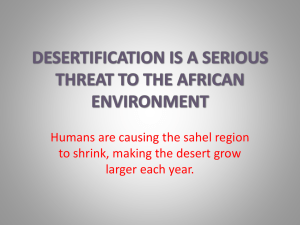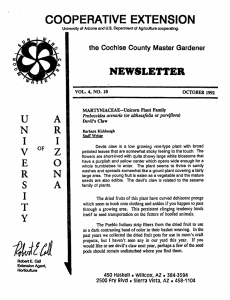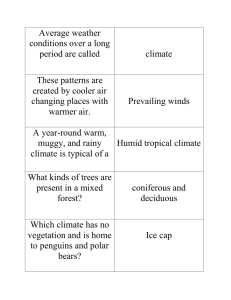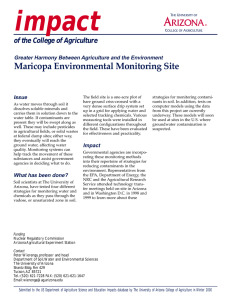COOPERATIVE EXTENSION NEWSLETTER
advertisement
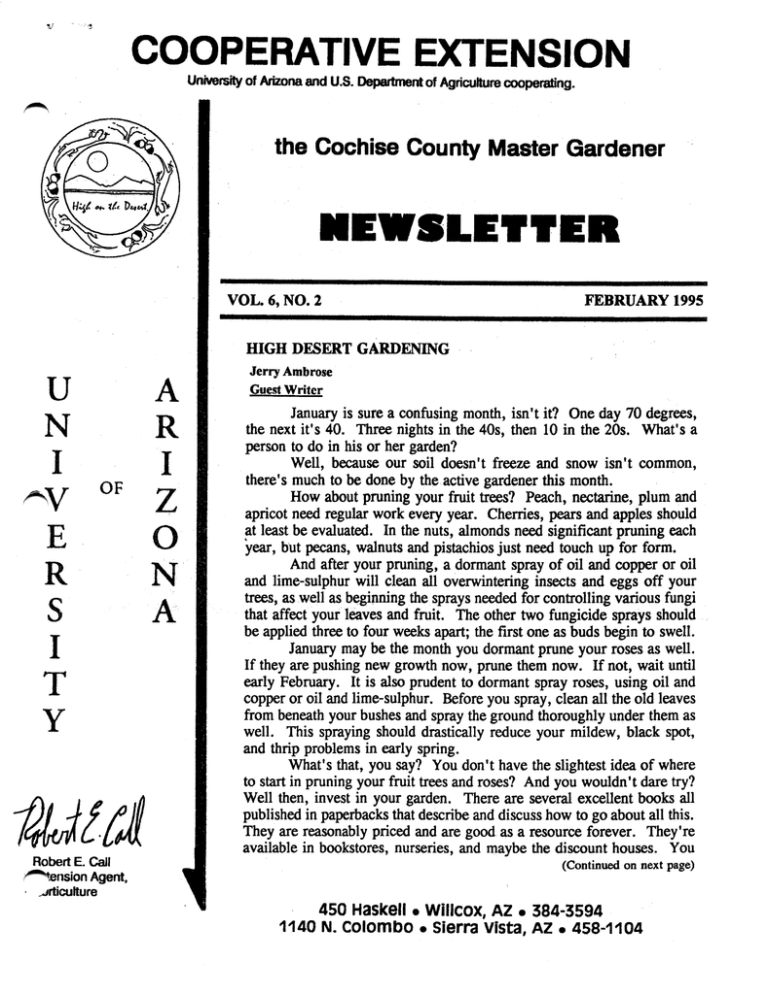
COOPERATIVE EXTENSION Universily ofAitzona and U.S. Department ofAgriculture cooperating. the Cochlse County Master Gardener 8 NEWSLETTER VOL. 6, NO. 2 FEBRUARY 1995 HIGH DESERT GARDENING Jerry Ambrose u N R I I A Guest Writer January is sure a confiising month, isn't it? One day 70 degrees, OF E R S I T Y 2 o N A the next it's 40. Three nights in the 40s, then 10 in the 20s. What's a person to do in his or her garden? Well, because our soil doesn't freeze and snow isn't common, there's much to be done by the active gardener this month. How about pruning your fruit trees? Peach, nectarine, plum and apricot need regular work every year. Cherries, pears and apples should at least be evaluated. In the nuts, almonds need significant pruning each year, but pecans, walnuts and pistachios just need touch up for form. And after your pruning, a dormant spray of oil and copper or oil and lime-sulphur will clean all overwintering insects and eggs off your trees, as well as beginning the sprays needed for controlling various fungi that affect your l^ves and fruit. The other two fungicide sprays should be applied three to four weeks apart; the first one as buds begin to swell. January may be the monA you dormantprune your roses as well. If they are pushing new growth now, prune them now. If not, wait until early February. It is also prudent to dormant spray roses, using oil and copper or oil and lime-sulphur. Before you spray, clean all the old leaves from beneath your bushes and spray the ground tooroughly under them as well. This spraying should drastically reduce your mildew, black spot, and thrip problems in early spring. What's that, you say? You don't have the slightest idea of where to start in pruning your fruit trees and roses? And you wouldn't dare try? Well then, invest in your garden. There are several excellent books ill MM Robert E. Call /*^ension Agent, published in paperbacks that describe and discuss how to go about all this. They are reasonably priced and are good as a resource forever. They're available in bookstores, nurseries, and maybe the discount houses. You (Continued on next page) ^rticulture 450 Haskeii • Wilicox, AZ • 384-3594 1140 N. Colombo • Sierra vista, AZ • 458-1104 might also borrow pne from the library. Give it a shot. If you still have questions after reading about it, check with your local nursery professional or with the Cooperative Extension advisor at the University of Arizona. Choose late-blooming varieties of fruit trees due to our propensity for hard frost until April 1, and plan to wait on figs until they're available in containers because it's generally too cold to establish them effectively from bare-root here. This is great lilac country, so look for them now in bare-root. [The Cooperative Extension offices in Willcox and Sierra Vista offer free pruning brochures. Call for a copy. Also, see information concern ing a free pruning demonstration elsewhere in this newsletter.] You can enhance your garden in January as well. January-February is the time of the year that many shade trees, ^ fruit trees, many small fruits and vegetables, and roses are available in the "bare-root" form at nurseries and garden outlets. Expect to find some 12-15 different shade trees and ornamental trees as well. Since this is such great stone-fruit country, apples, apricots, pears, peaches, plums, prunes, asian pears, cherries, and nectarines should be available. Pecans, walnuts, almonds, pomegranates, and persimmons will round out the normal availabili ty but look around a bit and you might find more exotic fare such as jujubes, filberts, and plumcots. There are many forms of fruit trees avail able—standard, compact, semi-dwarfand genetic dwarf—so there are sizes to fit any garden. Rvtn! Con ^t TiWie IS getting short * The "W-igfh desert (»^r^enin^ & CjcindsGCiping Conference IS (ess th^n 2 weeks I^e^ister right now! forni inclMded in this newsletter! You should also be able to find blackberries, raspberries, strawberries, artichokes, rhubarb, asparagus, horseradish, and Jerusalem artichokes. Have fun looking! Arid there are roses . . . The newest and best varieties are available in bare-root now. All American Rose selections are those varieties that have tested highest in test gardens all across America, and while normally more expensive, they typically do best overall. There are some great varieties out there that cost less, too, so check with your local nur^ry professional or theCooperativeExtension office at the Universi ty of Arizona for varieties suited to Cochise County. Remember to dig wide holes and add soil sulfur and organic matter when you plant most of the above. Roses and fruit trees will need some special care because of our windy cli mate—check with your local nursery profession al for details. I—-— Staff; BanyR. Bishop Jan Groth Carolyn Gruenhagen Elizabeth Riordon Virginia Westphal MASTER GARDENER 1994 NEWSLETTER ABRIDGED INDEX Agent's Comer, Jan/p. 2; Feb/p. 2; Mar/p. 5; Apr/p. 4-5; May/p. 5, Jun/p. 2; Jul/p. 5; Aug/p. 3, Sept/p. 4; Oct/p. 5; Nov/p. 5 Apple Tree Early Flowering Q & A, Feb/p. 2 April Reminders, ^pr/P. 2 Garden Tip # 2937, Aug/p. 5 Garden Tip # 6729, Apr/p. 6 Garden Tip It 8639, Jun/p. 3 Arizona Cypress Ne^le Browning Q&A,Jun/p.2 Garden Tour Announcement, Aug/p. 6 Globe Willow Sap, Aug/p. 3 Gopher Problem Q&A, Apr/p. 4-5 Arizona Cypress Problems, Sq)t/p. 4 Graduation, MasterGardenerClassof Spring '94, Arizona Master Gardener Conference Announce ment, Jun/p. 4 August Reminders, Aug/p. 5 Jun/p. 6 Grapes, Aug/pp. 1-2 Grape Water Problem, Jul/p. 5 Backyard Bird ProblemsFree Pamphlet, Nov/p.2 Bees and Hummingbird Feeders Q&A, Mar/p. 5 High Desert Flowering Deciduous Plant Recom mendations, Sept/p. 2 Bio Babble, Jun/p. 5 Bird of Paradise, Apr/p. 1 Border Volunteer Corps Training, Sept/p. 4 Bulbs for Fall Planting, Dec/pp. 1-2 High Desert Gardening & Landscaping Confer ence Program, Jan/pp. 3-4; Feb/pp. 3-4 High Desert Gardening & Landscaping Ccmference Highlights, Apr/p. 3 High Desert Gardening & Landscaping Confer Caesalpinia gilliesii. See Bird of Paradise Chilopsis linearis. See Desert Willow Christmas Cactus Q&A (Agent's Comer), Jan/p. 2 Christmas cactus Care, Dec/p. 4 Cooperative Extension Free Bulletins, Nov/p. 1 Coming Events, Mar/p. 6 Compost & Mulch For Sale By City, Feb/p. 2 ence Highlights, May/p. 6 Hill Planting, Oct/p. 6 Holiday Cactus care, Dec/p. 4 Holiday Plant Care, Dec/pp. 3-4 Huachuca Mineral and Gem Show Announce ment, Oct/p. 2 Hummingbird Feeder Care, May/p. 6 Hummingbird Feeder Problem, Mar/p. 5 Conference Huge Success, Mar/p. 2 Container Gardening, Oct/p. 4 County Agent Rob Call. See Agent's Comer Crape Myrtle, S^t/p. 1-2 Cutting 'N' Clippings, Apr/p. 5 December Gardening Chores, Dec/p. 2 Desert Willow, Jun/pp. 1-2 Dividing Miniature Roses, Apr/p.5 Dried Tomatoes, May/p. 2 Index, Master Gardener 1993 Newsletter, Mar/ pp. 3-4 June Reminders, Jun/p. 4 July Reminders, p. 5 Kishbaugh, Barbara Farewell, Nov/p. 3 Lagerstroemia indica. See Crape Myrtle Land Grant System, Sept/p. 5 Elfrida Field Trip Announcement, Sept/p. 6 Elfrida Trip Described, Oct/p. 3 Elm Trees aiid Beetles Q&A (Agent's Comer), May/p. 5 Euphorbia pulcherrima. See Poinsettia List of Published Master Gardener Newslet ter, Pest-Related Articles, Feb/p. 6 March Reminders, Mar/p. 2 May Reminders, May/p. 6 Master Gardener Spring Class, Jan/p.2; Feb/p. 2 Math for Gardeners, Nov/p. 4 Fabulous Fall, Oct/pp. 1-2 Fresh Farm Produce List, Jul/p. 6 Fertilizer Bag Numbers Q & A (Agent's Comer), May/p. 5 Mesquite, Jul/pp. 1-2 Mesquite Flour from Mesquite Beans, Jul/p. 2 Mesquite-pitch Pottery Paint, Aug/p. 2 Mesquite Twig Girdlers, Jul/p. 5 Mulches, Sept/p. 3 Gardening Hints, Apr/p. 5 Garden Vegetable Planting for Fall Harvesting, Aug/p. 3 November Reminders, Nov/p. 4 Nursery Prof, Training Announcement, Sq)t/p. 3 Help Wanted! Index continued: October Reminders, Oct/p. 2 Onions and Seed Heads Q & A, Jun/p. 2 Oregon Master Gardener Conference Announce ment, Aug/p. 3 Peas, Feb/p. 1 Pecan Harvesting Readiness, Nov/p. 5 Phone Book Recycling Announcement, Nov/p. 2 Poinsettia, Jan/pp.1-2; Dec/pp. 3-4 Pre-emergent Herbicide, Oct/p. 5 Pruning Fruit and Shade Trees, Nov/p. 5 Pumpkin Festival Announcement, Oct/p. 2 Master Gardeners, your help is needed as room monitors and visual aid assistants for the High Desert Gardening & Landscaping Confer ence, Ifyou can help, please con tact Grady Banister, 378-6737, TREES FOR SALE The Arizona State Land Department Forestry Radical Gardener Definition, Dec/p. 3 Raking leaves, weeds, and trash into Plastic Bag, See Garden, Apr/p. 6 Raspberry Water I*roblem, Jul/p. 5 Rock Handler, Aug/p. 5 Rosa Arizonica, Mar/p. 1 Division, with the cooperation of the U.S. Forest Service, Soil Conservation Service, Cooperative Extension Service, and nursery contractors, annually supplies tree seedlings to rural landown ers for windbreaks, reforestation, erosion control, Safe Food Handling Free Pamphlet, Nov/p. 2 wood products, wildlife habitat, and Christmas tree plantations. These seedlings are bulk pur Salt Cedar. See Tamarisk chase, stored, and redistributed tothe landowner Say it With Flowers, Jun/p. 5 Schlumbergera bridgesii. See Christmas Cactus Scorpions in Southern Arizona, May/pp. 3-4 Seed Catalogue Interpretation, Jun/p. 5 September Reminders, Sept/p. 2 Slime Flux Infection, Aug/p. 3 Soil: Alkaline or Acid, Dec/p. 5 at the lowest possible cost. The purpose of this program is to encourage rural residents to estab lish tree and shrub stands for conservation pur Solar Greenhouses, Part VII, Jan/pp. 5-6 Solar Greenhouses, Part XVIII, Feb/p. 4 Solar Greenhouses, Part IX, Apr/p. 2 Squash Vine Borer, Jul/pp. 3-4 Strawberry Water Problem, Jul/p. 5 Summer Safety Tips, Aug/p. 4 Summer Squash Not Producing, Jul/p. 5 Surflan. See Pre-emergent Herbicide Tamarisk, May/p. 2 Thanksgiving Essay, Nov/p. 6 Tomatoes, May/pp. 1-2 Turkey Roasting Hotline, Nov/p. 2 poses. The variety of species offered to the public by the State Land Department, Forestry Division, is a compromise between public demand, seedling stockavailable, and variety of climatic conditions existing within the state. Bareroot seedlings are sold in bundles of 50 plants (18" - 36" in length). Small Container Seedlings are sold in multiples of 30 seedlings (each root container is 1" x 1" x 10". Top height of seedling is 6" - 10"). Large Container seedlings are sold in multiples of 30 seedlings (each root container is 2" x 2" x 7". Overall height is 12" to 18"). For more information or APPLICATION TO PURCHASE SEEDLING TREES contact the Willcox or Sierra Vista Cooperative Extension Office, the U.S. Forest Sierra Vista Ranger Water Drill Home-made, Jun/p. 3 Wet Wood Infection, Aug/p. 3 What's Bugging You, Feb/p. 5; Jul/p. 3 Wood Ashes as Soil Additive Q & A, Feb/p. 2 Xeriscape, What is it? Jun/p. 4 District, 5990 S. Hwy 92, Hereford, or the Arizona State Land Department, Forestry Divi sion, 233 N. Main Avenue, Tucson, AZ 85701 (tel. 602-628-6016). All orders must be received at the Flagstaff office at least two w^ks prior to the scheduled pickup date, regardless of the desired pick-uplocation, so don't delay. Time is getting short! IT'S NOT JUST "DIRT" maintain it for another IS minutes. Barry R. Bishop hours before using. Remove from the stove letting it cool down. Wait 24 Staff Writer This general-purpose mixturecan be used for Every time you turn around, businesses are advertising potting soil at what appears to be a special low price. They say this bag is two cubic feet, this bag is such and such, this bag is three yards and so on. If you are like me, confusion is my middle name. What this all means is great if you know what is being offered, and sizes, of course, but 1 don't. So I have studied arid come up with a good potting soil yOu can blend yourself. The soil in which house plants and even starter inside beds have in them requires a little more attention than plants grown in the outdoors. It is most impor tant in any artificial growing medium to have the right proportions to provide the right nutri ents needed to sustain plant growth. Ideally we should have sterilized soil to ensure freedom from soil-borne pests, diseases, and weeds. There are three methods to use to sterilize the soil: 1. Formaldehyde Method — To treat soil in a flat 16 by 22 by 2 inches deep, mix 4 tablespoons for formalin (40% formaldehyde) with 6 tablespoons of water. Apply this out doors. Moisten the soil, sprinkle the solution on it, mix the two well, then cover with plastic for 12 hours. Air for another 24 hours (or until all odor disappears) before sowing seeds. 2. Oven Method — Place a 4 inch layer of moist soil in a metal baking pan and cover with aluminum foil. Insert a candy or meat ther mometer in the soil through the foil. Place the pan in the oven using low heat. When the thermometer has a reading of 180-200 degrees leave in the oven for another half hour. Re move the pan from the oven and let set for 24 hours. 3. Pressure Cooker Method — Fill a canning type pressure cooker with 2 cups of water. Place a rack inside the cooker and stack shallow pans of soil (approximately 3/4 of an inch deep), leaving space for the steam to circu late. Heat and when 10 pounds are reached, most everything that have strong root systems: 2 parts garden soil (the soil you sterilized) 1 part peat moss or leaf mold 1 part perlite, coarse sand, or bird gravel 1/4 part bone meal or 1/8 part superphosphate 1/2 part dry cow manure For plants that need a soil with more organic matter, such as begonias and African violets, use the above mixture with double the amount of peat moss or leaf mold. For plants such as azaleas, camellias, and gardenias, double the peat moss and dry cow manure and use superphosphate instead of bone meal. For desert cacti and succulents, a moist, very porous potting mixture is essential. By volume use 2 parts of soil, 2 parts perlite, 1/4 part bone meal, and 1/2 part dehydrated cow manure. Note: Purchased potting soil can be stretched by adding 1 part garden soil to every 3 parts purchased soil. TREES FOR SCHOOLS ARBOR DA Y '95 PROJECT Arbor Day - AprU 28, 1995 Class projects and/orschool-wide projects are being sought for Arbor Day '95. Proposals should involve staff, students, and parents. Projects may involvea periodof one day, one month, or longer and should be integrated as a thematic unit with your curriculum - science, literature, writing, art, music, ax)logy, math, health/safety, social studies, geography - one of these or any combination of all of them. The use of trees should be specified - windbreak, shade, reading, hugging tree - whatever your group desires. Design assistance is available through De Lewis, 458-4170 andSteve Schliebs, Q o o ti 2^ Eu 3 o S9 go p n o =r 3 o c/a JL fT^ •o cr o 9 2: > 8 7^ S W sr Si •• D o- p. 3 sr fp rt o- Lunch, Door Prizes & Exhibits 12:00 -1:30 pm Thursday, February 16,1995 Registration and Breakfast 7:30 - 9:00 am Welcome and General Session 9:00 -10:00 am Gary Paul Nabhan, PhD*, Lessons From the Desert Elders: Food and Health in Dry Lands Session I 9 ^ C/) Session VI 2:00-3:30 pm A. Bill & Athena Steen, Straw Bale Construction B. Tom DeGomez, Growing Strawberries and rt n o 9 a Brambles w a 2- s^CO ra Conference Program r 8 n «-• III O 9 cr. 3 cr s 3^ ^ o fi ^ > 1§ " S H ^ 5 S § %' GO 3 *8 8 8 10:30 -11:45 am A. Matthew B. Johnson, Mesquites In High Desert > C. Mike Meritwin, Composting - The Oldest Form of Recycling 9 9 Landscapes B. Mike Kilby, PhD, Table and Wine Grapes C. Tom Doerge, PhD,/mprov/wg Sb/fa Session Vn 9 9 3:30 - 5:00 pm met A. Kevin Dahl, Less Work, More Production With 9 Permaculture > 9. o n g o 9 9 s* gu C s n CO fi b o •§ p Lunch, Door Prizes & Exhibits 12:00 -1:00 pm Session n 1:30 - 3:00 pm A. Peter Gierlach, Grow Native or Move Back to Ohio B. Donna Ellsworth & Roberta Gibson, Bees, Butterflies and Other Beneficials C. Jimmy Tipton, PhD, Roots - Whafs Going on Underground s o 9 > 00 *' I 9. rz^ S5 4i» KJi 00 O o 9mm. t d) W < o £B •• o 3 g* 8 0 3 X 1 PCO o si n m T3 < 1 to 3 i. 00 u* 0 13 9* 00 3:00 - 4:30 pm 22 o' 9 C Roberta Gibson, Ants In Your Plants Session IV 4:30 - 5:45 pm A. David Eppele, Agaves For Landscapes B. Page Bakarich, WildflowersU C. Deborah Young, PhD, D/agnosmg P/anr Problems Friday, February 17,1995 Re^stration and Breakfast 7:30 - 9:00 am O General Session 3 8 Howard Shapiro, PhD, Sustainable Agriculture and Biodiversity 9:00 - 10:00 am On u) Lo Session V 10:30 -11:45 am A. Joel Glandsburg, Anasazi Water Harvesting B. Dale Leiendecker, Growing Vegetables C. Dick Kelley, ^r/20/ja Odfcy o B. Janet Rademacher, New Water-Efficient Plants For the High Desert C. Terry Mikel, So/'/, P/awf, Water Relationships 9* 5:00 - 6:30 pm Reception Entertainment by Busted Cowboys y ^ o 9 9 •2 9 Saturday, February 18,1995 - Optional Tours A. Ron & Norma Murray, Cactus Gardening B. Rob Call, Fruit Tree Pruning Demonstration " 3. §• 9? a C. Bill & Athena Steen, Straw Bale Construction A, Jim Koweek, Do Your Own (DYO)Landscape B. Elliot Edwards, Gourd Culture and Crafting a 3 0 o H Session in TO All tours are included in the registration fee. Transportation is on your own with carpooling suggested. Maps will be provided. The number of participants is limited to the first 20 to register for the Cactus Gardening tour. Please indicate on the registration form. TO VO i-i a fi 9 * Dr. Gary P. Nabhan first moved to Tucson in 1976 "S. to serve as a Research Assistant at the Arizona Sonora TO Desert Museum, where he also served as Writer-in-Residence before becoming StaflF Science Advisor in December 1993. He has a B.A. from Prescott College and an M.S. and PhD from the University of Arizona. He is a cofounder of Native S^ds/SEARCH as well as author of eight books and over fifty technical articles on ethnobiolo^, natural history and desert life. Robert E. Call, Extension Agent, Horticulture P 9 ?? n 9 n o I THE AGENT'S OBSERVATIONS Robert E. Call Horticulture Agent QUESTION: Can I prune pine trees and juniper shrubs during this winter? ANSWER: Pruning of pine, juniper, ceder, fir, and spruce tree and shrubs should be done during the spring. Pruning is a stressful event for nearly all plants. The mentioned conifers are not growing much if any during the winter season and will have growth start in the spring. Waiting until spring to prune or trim these plants will afford them the opportunity to heal properly because of the strength they will have during the spring push of growth. QUESTION: What are these fuzzy brown spots about l/8th to 1/4 inch in diameter on the underside of oak leaves? The affected oak trees were planted last spring. ANSWER: At first it looked like an egg mass of a lepidoptera, that is the moth and butterfly family. After further examination of the sample leaf it was determined to be a gall of the woolly leaf gall caused by cynipid wasp. Other gall forming insect are other wasps, aphids, psyllids or other insect. Most galls are formed as a reaction of the plant to larval feeding or adult egg laying. Most of the time the gall is formed from the reaction of chemicals that the insect secretes which produces mutation of plant cells. This abnormal tissue many times provides cover over the newly laid or hatched eggs. Also many times the inside gall tissue is a food source for newly hatched insects. QUESTION: Is it all right to have red deli cious apple trees blooming now? Why is this happening? ANSWER: It is not good or normal to have fruit trees blooming this time of year. Those flowers will be frozen and die and not produce any fruit. This is happening because of the weather. There is not anything that can done about it without drastic measures like growing in a temperature controlled greenhouse. The trees have not had proper chilling, that is not enough hours in the cold. Let me explain. When there is not prolonged low temperatures, that is tem peratures between 32 and 59 degrees P., the chill requirement is not fulfilled. Time between these temperatures accumulate chill hours, with 43 degrees being optimum. Each hour above 60 degrees negates an hour of chill accumulation. For red delicious apples 1,234 hours of chill are required to overcome dormancy. Other decidu ous fruit trees have other total chill require ments. Without this chill requirement normal growth will not occur, flowering can be sporad ic, small leaves and fruit, short shoot growth and low yields will result. That is the reason standard apple trees do not grow or produce well in Tucson, Phoenix, Yuma or other warm areasof Arizona. They plant low chill requiring apple trees which do not have the fruit qualities that "normal" chill varieties have. To grow citrus you can not have too much cold and to grow apples you need to have cold winter weather. r| Our deepest sympathy is extended to newsletter staff writer, Jan Groth, and her family. Jan's brother, John Fitzgerrell, was killed in an airplaneaccident last week near Marana, AZ. Issu^ in furtherance of Cooperative Extension work, acts of May 8 and June 30, 1914, in cooperation with the United States Department of Agriculture, James A. Christemoii, Director, Cooperative Extension, College of Agriculture, TheUniversity of Arizona andArizona Counties cooperating. TTie University of Arizona College of Agriculture is an equal opportunity employer authorized to provide research, educational information and <^er (services only toindividuals and institutions that function without regard tosex, race, religion, color, national origin, age, Vietnam Era Veteran's status, or disability. The information given herein issupplied with the understandiiig that nodiscrimination isintended and noendorsement byCooperative Extension is implied. Any products, services, or organizations thatare mentioned, shown, or indirectly implied in thispublication do notimply endorsement by the University of Arizona. CCX)PERATJVE EXTENSION U. S. DEPARTMENT OF AGRICULTURE THE UNIVERSITY OF ARIZONA BULK RATE POSTAGE A FEES PAID TUCSON. ARIZONA 85721 USOA PERMIT No. G26« OfFiClAl 8USINCSS pcnacty pwivatc us€ woo Address correction requested It' s time to prvine yovir trees! Come to €\ free prMningi demonstration, M^rch 8 10:00^m ' 14oon by l^ob C^lt, A^ent 8144 D^kot^ Ro^d - "W-ereford Directions: Front Sierr^i Visto, «(rive South on Wwy 92, turn (eft on to l^^inisey ^04«(, turn ri^ht on to Moson 1toA<( €tnd tr<ive( ^ibout »Hi(e to DeikotA. Turn (eft on to PiGkota to the thir«( street, (»-eer 1^oci«l. Turn on to (S'oer flo<9«(, which is the WrivewAy, en<( continue ebout 1/^ Hii(e to the houie. For »uore information c«i(( Sy«(ney Vuncevich c»t 5?e 0930. J


